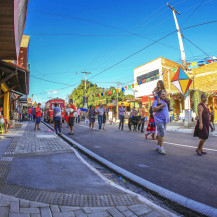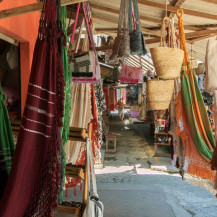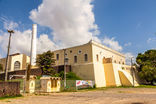“Olha que isso aqui tá muito bom” ("Look, It's very good here")
4 daysA tour through some of the biggest June festivals in the Country, in the footsteps of forró (a genre of Brazilian music) and Bumba-Meu-Boi.
“Olha, que isso aqui tá muito bom, isso aqui tá bom demais!
Olha, quem tá fora quer entrar, mas quem tá dentro não sai!”
The song by the great accordion player and composer Dominguinhos sets the tone for the feast: when there is good music, everyone dances and no one wants to leave.
And you will find lots of quality music in the best popular festivals of Brazil: the June festivities (also known as São João), which traditionally take place in the month of June. In addition to typical food, various games, quadrilhas (a dance which is typical of the feast), a mock-up caipira (Brazilian hillbilly) wedding and, of course, lots of joy, which lasts all night.
Feel like dancing yet? So, get ready and follow the rhythm of this tour through some of the biggest June festivities in the Country. One day in each of them. However, the distances between the destinations are very long, which makes going from one to another difficult. If you prefer and have time to do this, you can split the tour into smaller trips, to get the most out of each city.
Campina Grande’s or Caruaru’s: which is the greatest São João in the Country? The two cities compete for the title every year and make each edition larger and better organized than the one before.
To start this trip, we're going to board a train, Expresso do Forró, which works only during the June festivals. Also known as Locomotiva Forrozeira, it departs at 10 a.m. from the station in Campina Grande and goes to Galante, located 18 km and 1 hour and a half away, unhurriedly. In each of the wagons, there is a forró group playing. Choose yours and practice the steps in advance, because in the next few days there will be lots of dancing.
At night, the feast continues in Parque do Povo, which hosts the famous São João of Campina Grande. During the month of June, more than a million tourists and dozens of artists gather there, ensuring music and excitement throughout the evening. When lacking energy, just recharge the batteries in one of the tents with typical delicacies, to then return to the dance floor.
Great for
Caruaru’s or Campina Grande’s: which is the greatest feast? This issue has not yet been resolved, has it? The truth is that this dispute has always the same winner: the audience, who can have lots of fun in these two great celebrations.
Feel free to think about this issue while visiting the famous Street Market, so beautifully sung by the famous musician Luiz Gonzaga. As the old Lua, nickname of the accordion player, used to say, "de tudo o que há no mundo nela tem pra vender" (everything there is in the world you will find there). And that is true. There are so many stalls, 12000, that it's not hard to get lost in there, amid foods, spices, clothing, crafts, housewares and even cars and motorbikes!
Later, the destination is Parque de Eventos Luiz Lua Gonzaga, that has 40000 m² and is where the São João of Caruaru happens which, of course, lasts all night long. As in Campina Grande, it includes dozens of artists, games, quadrilhas and treats. A curious fact: during the feast, there is a marathon of giant foods, when the population gathers together to make the biggest pé-de-moleque (traditional candy made from peanuts and jaggery or molasses), pamonha (a paste made from sweet corn), corn cake and mungunzá(traditional sweet dish) in the world.
The Bumba-Meu-Boi of Maranhão is a feast unlike the above. While the others have Catholic roots, this celebration has its origin in the legend of Pai Francisco, an enslaved man who killed his lord’s ox to satisfy the will of his pregnant woman who craved the tongue of the animal. Desperate, the lord called shamans to try and resurrect it. When it came back to life, they all gathered in a great celebration.
But Bumba-Meu-Boi also bears similarities with the June festivities: it occurs in the months of June and July (although there are events throughout the year) and is the most popular feast in the region, bringing together thousands of people who occupy the streets of São Luís, dancing all night long and delighting themselves with the typical foods of the celebration. So we can include it in this tour.
A part of the feast happens in Ceprama, the Center for Promotion of Crafts of Maranhão. The old factory serves as the stage for Bumba-Meu-Boi. During the day, it houses the most important local crafts market, where you can see and buy goods made by craftsmen from Maranhão. These include sculptures, nets, clothes, lace, housewares and more. It is worth a visit, for these two reasons.
And if you're looking for something to do before the festivities, be sure to visit the Lagoa da Jansen Ecological Park, one of the symbols of São Luís. With 6000 square meters, it has a promenade for walks and exercising during the day, in addition to many bars and restaurants which thrive at night.
And are there June festivities outside the states in the Northeast of Brazil? You bet there are. And all across the Country, too. One which stands out is São João do Cerrado, in Ceilândia, a city near Brasília, held annually for four days between July and August. It is worth it to visit the country's capital before giving in to the dancing.
As time is short, prioritize the central area of the city, where its main monuments are located, such as Praça dos Três Poderes (Three Powers Square), from where you can see the headquarters of the Legislative (the National Congress), Executive (the Presidential Palace) and Judiciary (the Supreme Court) powers.
From there, go to the Metropolitan Cathedral, designed by Oscar Niemeyer, beautiful, in the shape of a crown of thorns. The first monument of Brasília, it has stained glass windows by the French artist Marianne Peretti and sculptures of angels, that seem to fly, by Alfredo Ceschiatti.
You also need to visit the TV Tower, with its food and crafts fair. From the viewing spot which has 75 meters in height, you may have a spectacular panoramic view of the city. It’s unforgettable.
At the end of the tour, walk to the bus station and take a bus or the subway to the Guariroba station, in Ceilândia. The Abadião stadium, which stages the São João do Cerrado feast, is next to it. You may also take a taxi and go directly to the location.
The feast is magnificent: with dozens of shows by several artists, it attracts thousands of people who consume tens of thousands of portions of food and drink.
See our recommendations
-
Craft fairs for you to return home with a full suitcase
-
The excitement of the Brazilian nights
-
4 parks to skateboard in the main capitals of Brasil
-
Football is in the genes of the Brazilian people
-
12 shopping centers for you to return home with full suitcases
-
Cultural traditions that make Brazil a unique place
-
Four locations in Brazil that allow sensorial experiences



